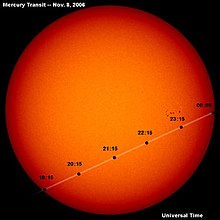
In the field of astronomy the term chord typically refers to a line crossing an object which is traversed during an occultation event. By taking accurate measurements of the start and end times of the event, in conjunction with the known location of the observer and the object's orbit, the length of the chord can be determined giving an indication of the size of the occulting object. By combining observations made from several different locations, multiple chords crossing the occulting object can be determined giving a more accurate shape and size model. This technique of using multiple observers during the same event has been used to derive more sophisticated shape models for asteroids, whose shape can be highly irregular. A notable example of this occurred in 2002 when the asteroid 345 Tercidina underwent a stellar occultation of a very bright star as seen from Europe. During this event a team of at least 105 observers recorded 75 chords across the asteroid's surface allowing for a very accurate size and shape determination.[1]
In addition to using a known orbit to determine an objects size, the reverse process can also be used. In this usage the occulting object's size is taken to be known and the occultation time can be used to determine the length of the chord the background object traced across the foreground object. Knowing this chord and the foreground object's size, a more precise orbit for the object can be determined.
This usage of the term "chord" is similar to the geometric concept (see: Chord (geometry)). The difference being that in the geometric sense a chord refers to a line segment whose ends lie on a circle, whereas in the astronomical sense the occulting shape is not necessarily circular.
- ^ "2002 European Asteroidal Occultation Results". euraster.net (a website for Asteroidal Occultation Observers in Europe). 2002-09-17. Retrieved 2008-12-03. (Chords)